Convalescent. Later, mental handicap.
Winifred House, Invalid Children's Convalescent Home, (Mrs Hampson's Memorial Home), founded in 1890, opened in 1891 in Wray Crescent, Tollington Park. It had 18 beds for poor children who needed surgical nursing care or were recovering from illness, although cases of debility (weakness) and rickets were also accepted. Apart from nursing care, treatment consisted of good food and fresh air. Those admitted were boys aged from 8 to 10 years and girls aged from 8 to 12 years. The weekly charge was from 4 to 5 shillings (20-25p), depending on the child's age and circumstances.
In 1905 the Home treated 49 patients, 15 of whom had tuberculosis of the hip or spine, 1 had infantile paralysis, 4 had rickets and 29 had debility due to various causes.By 1906 the name had been changed to the Winifred House Children's Convalescent Nursing Home. It was managed by the Invalid Children's Aid Association, who referred the majority of patients, with the remainder being sent from the major teaching hospitals in London.
In 1909 the name was changed again to the Winifred House Children's Convalescent Hospital Home.
By 1920 it was known as Winifred House, Invalid Children's Convalescent Hospital Home (Mrs Hampson's Memorial Home).
In 1936 a plot of land in Arkley was bought and the foundation stone for a purpose-built Home was laid by Mr G.B. Mower White, F.R.C.S., on 21st November.
The Home moved to its new premises in 1938. It had been built at a cost of £30,000 and had 40 beds in spacious accommodation. The children's dormitories were on the ground floor, divided into wards containing 8 to 12 beds each. They were well-furnished and each child had its own locker and overbed table. The washing facilities were adequate, with wash basins provided at different heights for the different age groups.
A terrace ran along the length of the southern side of the building, and was large enough for beds to be wheeled out onto it in the summer, and to provide a play area during bad weather.
The Home also had a surgery, a physiotherapy room and a 2-bedded isolation ward.
The staff living quarters were on the first floor.
The Home admitted boys aged from 2 to 10 years and girls from 2 to 12 years, but sometimes babies were also taken in. Some patients remained at the Home for three years, but the length of stay could be as short as 2 weeks.
Children who were immobilised in plaster following treatment for joint or spinal tuberculosis (TB) were accepted as long-term cases for a minimum of 3 months. Other cases admitted were those with osteomyelitis, TB meningitis and asthma. Those excluded were children with heart disease, contagious infections and epilepsy. Treatments provided included physiotherapy and ultraviolet therapy.
In 1948 the Home joined the NHS as the Winifred House Convalescent Hospital for Children under the control of the Barnet Group Hospital Management Committee, part of the North West Metropolitan Regional Hospital Board. Most patients were long-stay asthmatics or orthopaedic cases, some of whom were bed-ridden. A Special School was set up to continue their education, which was later taken over by Middlesex County Council. It had two schoolrooms and was run by a headmistress and two teachers.
The Home's regime meant that the children had to be up by 07.00 every morning and in bed by 19.00, with a compulsory rest in the afternoon.
In 1950 the average length of stay was 7 to 12 months but, by 1960, about 9 months (by 1969 it was one month).
In March 1962, when a small hospital for mentally handicapped children within the Barnet Group closed, the Home agreed to accept such children.
By 1969 half the beds were set aside for mentally handicapped children, most of whom were referred by Mental Welfare Officers, usually for social reasons (that is, so their parents could take a holiday). Most convalescent patients were referred from London hospitals, but also from further afield, such as from Luton or Bedford. They, too, could be admitted for respite care if a mother had no-one to care for the child while she was in confinement.
The nursing staff consisted of a Matron, one full-time and one part-time Sister, and pupil nurses on secondment (usually 10 at a time) for 8 weeks from Clare Hall Hospital, Finchley Memorial Hospital and St Stephen's Hospital. Also employed were a physiotherapist, 2 teachers, and 1 full-time and 5 part-time domestic helpers. The Home had no Resident Medical Officer, but there were 2 visiting GPs and a visiting clinical assistant for the mentally handicapped children.
Night duties were covered by a Sister, 2 State-Enrolled Nurses and 2 nursing auxiliaries.
In 1971, because of the improvement in living standards, the facilities in the convalescent section had become greatly underused. It was decided that the Home, which cost £40,000 a year to run, would be dedicated solely to the care of mentally handicapped children, mainly from Cell Barnes and Harperbury Hospitals.
In 1974, following a major reorganisation of the NHS, the Home came under the administration of the Edgware/Hendon District health Authority, part of the North West Thames Regional Health Authority.
In 1982, after another major reorganisation of the NHS, the Home came under the control of the Barnet District Health Authority. It had 31 beds.
In 1992, following yet another NHS reorganisation, it joined the Barnet Healthcare NHS Trust.
The Home finally closed in 1999.
Present status (June 2008)
The building has been demolished and a small part-gated luxury estate built by Countryside Properties now occupies its site.

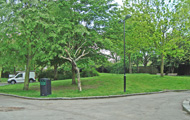
The site of the first Home in Wray Crescent is now part of a small park.
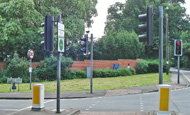
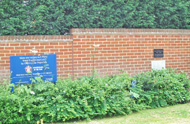
The boundary of the property in Arkley from Hendon Wood Lane (left), with the foundation stone set in the wall (right).
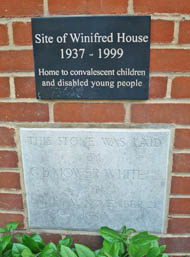
The developers have mounted a plaque above the 1936 foundation stone in the boundary wall.
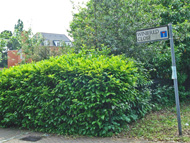
The entrance to Winifred Close.
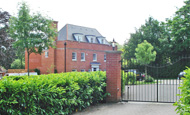
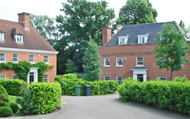
Houses in Winifred Close.
Copeland Bowie W (ed) 1903 The Essex Hall Year Book for 1903. London, British and Foreign Unitarian Association.
www.aim25.ac.uk
www.margaretthatcher.org
Return to home page